Concrete rings are a good material for making sewerage systems in private households. A septic tank made of concrete rings allows you to organize wastewater treatment up to 70%, but the percentage of processing in it is lower than in high-tech biological stations (98%). If the territory does not belong to nature protection zones, then you can save on the sewage system, since the cost of such a septic tank is half the price of buying a treatment station.
Before starting work, it is necessary to determine the type of soil on the site. The choice of a filtration system depends on its characteristics, since the design of a septic tank made of concrete rings involves several containers. According to sanitary standards, water must be subjected to three-day or more sedimentation before being discharged into the ground.
The type of soil can be determined by digging a hole, interviewing neighbors who own a well or a well, requesting information from an organization conducting construction or drilling near the site.
If the site is located in a hilly area, it is most likely of rocky soil. In this case, you need to make a choice in favor of ground treatment stations or storage tanks.

The clay throughput is practically zero. Soil of this type belongs to the category of waterproofing - water-repellent rocks that do not absorb and do not pass water through their thickness.
The filtration coefficient is slightly higher for loams, slightly higher for sandy loams. However, their filtration properties are still not enough for the installation of ground wastewater treatment systems on the listed clay soils.
In addition, heaving is inherent in almost all clay soils - the ability to increase in size during freezing and decrease during thawing. These ground movements can easily push concrete containers outward, completely destroy or simply squeeze them until cracks appear.
Sandy, gravel, pebble and gravelly sedimentary rocks have good absorbing properties. They freely pass water into their thickness, do not interfere with its movement into the underlying layers. True, coarse-grained deposits, such as gravel and pebbles, occur mainly in the floodplains of rivers, and crushed stone at the foot of mountain formations.
On river and mountain slopes, filtering structures are not suitable, because part of the drainage liquid will not be able to pass a tertiary treatment cycle sufficient for disposal into the ground. Therefore, the normal conditions for the construction of filtration fields, absorption wells and the installation of infiltrators are sandy soils of all sizes and density of addition, except for silty soils.
In addition to geological conditions, it is necessary to comply with the norms of its location from residential buildings and water sources.
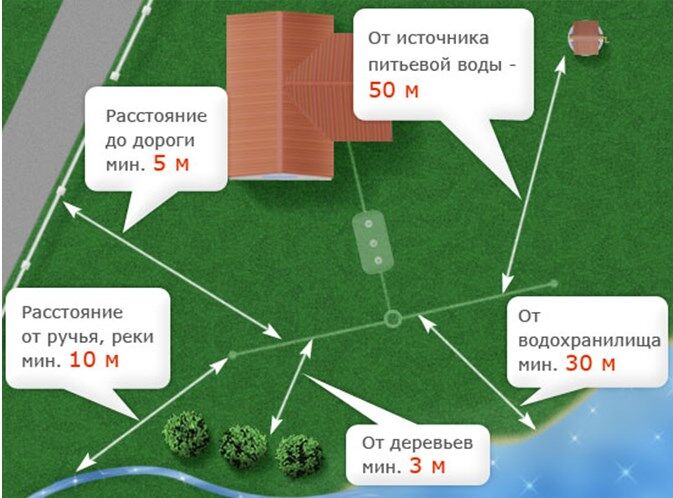
This information is spelled out in sanitary standards and must be observed. It is worth avoiding the location of the septic tank close to the place where the trees grow, as their root system can harm the structure
If sanitary standards are neglected, biological contamination of the water can occur. Dangerous pathogens of infectious diseases develop in sewage. These include E. coli, which causes severe poisoning. It easily gets to the source of drinking water through groundwater.
How to calculate the required volume
To organize a septic tank from concrete rings, it is necessary to calculate the volume based on the daily water consumption. According to the norms, one permanent resident has 200 cubic liters of water per day.
The first tank for settling wastewater should not have a volume of three times the consumption (200 liters) for each person. The second container with a bottom for settling should have a volume equal to 1/3 of the size of the first. The number of rings can be determined by dividing the volume of the container by the volume of the ring. They are small, medium and large in size.
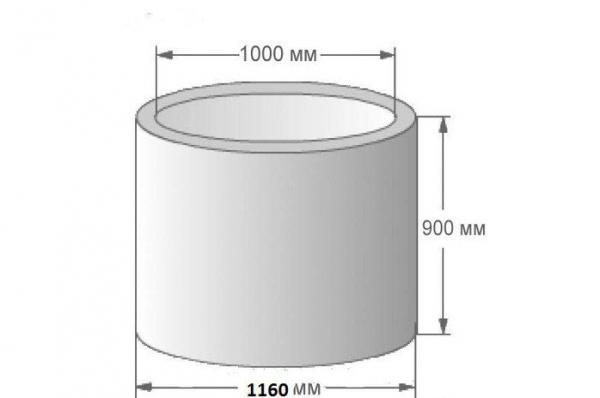
For the calculation, the parameters of the medium-sized ring will be used. KS-10-9 with an inner diameter of 1 m and a height of 90. One ring has a volume of 700 cubic liters
For a family of two:
The volume of the first container = (200 * 2) * 3 = 1200 cubic liters.
The volume of the second and third containers = 1200/3 = 400 cubic liters.
Number of rings for two containers = (1200 + 400) / 700 = 4
Number of rings for three containers = (1200 + 400 + 400) / 700 = 5
2 rings for the sump, 2 for the sedimentation tank and one for the drainage well
For a family of three:
The volume of the first container = (200 * 3) * 3 = 1,800 cubic liters.
The volume of the second and third containers = 1,800 / 3 = 600 cubic liters.
Number of rings for two containers = (1800 + 600) / 700 = 4
Number of rings for three containers = (1800 + 1200) / 700 = 6.
2 rings for the sump, 2 for the sedimentation tank and two for the drainage well.
Types of septic systems
Schemes of septic tanks made of concrete rings imply the presence of one, two or three chambers, where the effluent settles and their biological processing takes place.
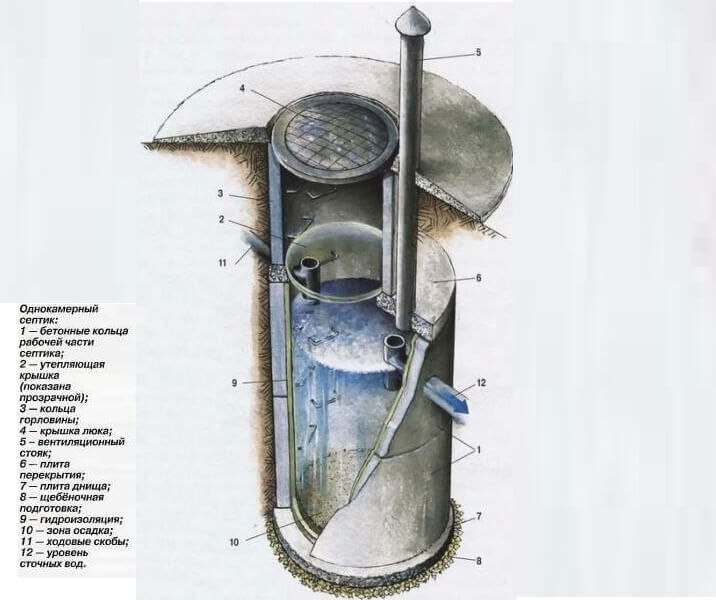
A single-chamber septic tank provides a three-day settling of effluents. It requires pumping out excess sludge every 3-6 months. The cleaning quality does not exceed 50% (+)
In fact, a single-chamber septic tank is an ordinary storage tank, from which wastewater is pumped out by flushers.

A two-chamber septic tank provides 5-6 days of settling of effluents. The cleaning level is 70%. It is necessary to pump out excess sludge every 12 months.
The first and second containers must have a bottom. This is followed by the third compartment, where soil cleaning is also carried out. The next stage of purification is the withdrawal of excess flow into the ground through the bottom of the filter well.
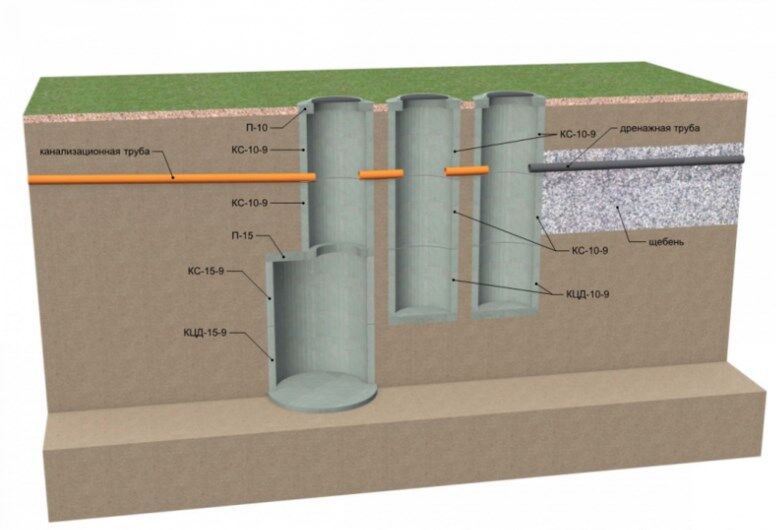
A three-chamber septic tank provides 7-9 days of settling of effluents. The cleaning level is 80%. It is necessary to pump out excess sludge every 2 years (+)
All chambers are arranged with a monolithic bottom, cleaning is carried out by settling. The settled liquid is discharged into an infiltrator or filtration field for subsequent disposal into the ground.
Depending on the absorption capacity of the soil, you can choose several filtration options for the device of a septic tank from concrete rings:
- Septic system with filtering field.
- Septic system with a drainage well.
- Septic system with filter cassette (infiltrator).
The most common filtration option is a sump. It is used with good soil absorption properties.

To increase productivity, its bottom ring is perforated. This increases the filtration area. If the groundwater level is less than three meters, this option must be abandoned (+)
Between the level of the conditional bottom of the absorption well and the highest level of groundwater in the autumn / spring rainy period, there is no meter required by the standards, a filtration field is installed. There must be enough space on the site for its construction.
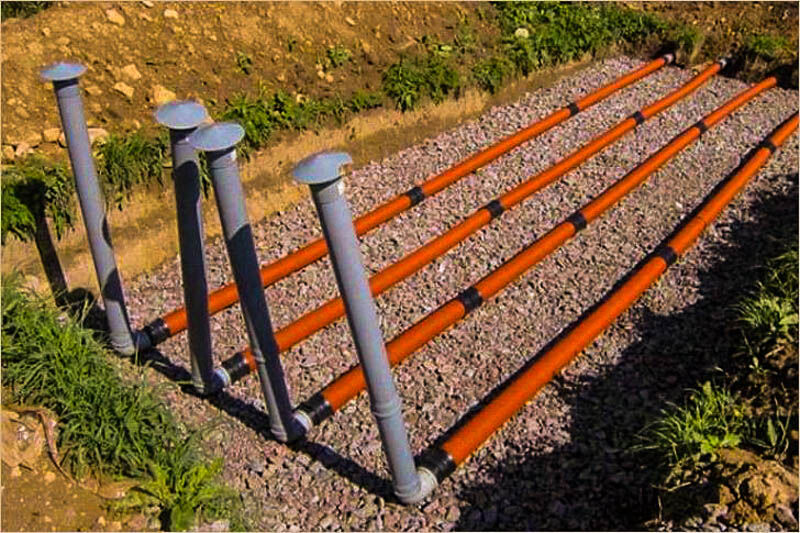
During its installation, perforated pipes or tunnels are used. For even distribution of wastewater between the septic tank and the filtration field, a distribution well is installed.
This is the optimal solution for areas where the groundwater level does not exceed 2.5 meters. It should be remembered that between the bottom edge of the drainage pipes of the filtration field and the top of the water-saturated layer, there must also be a soil thickness of at least one meter.
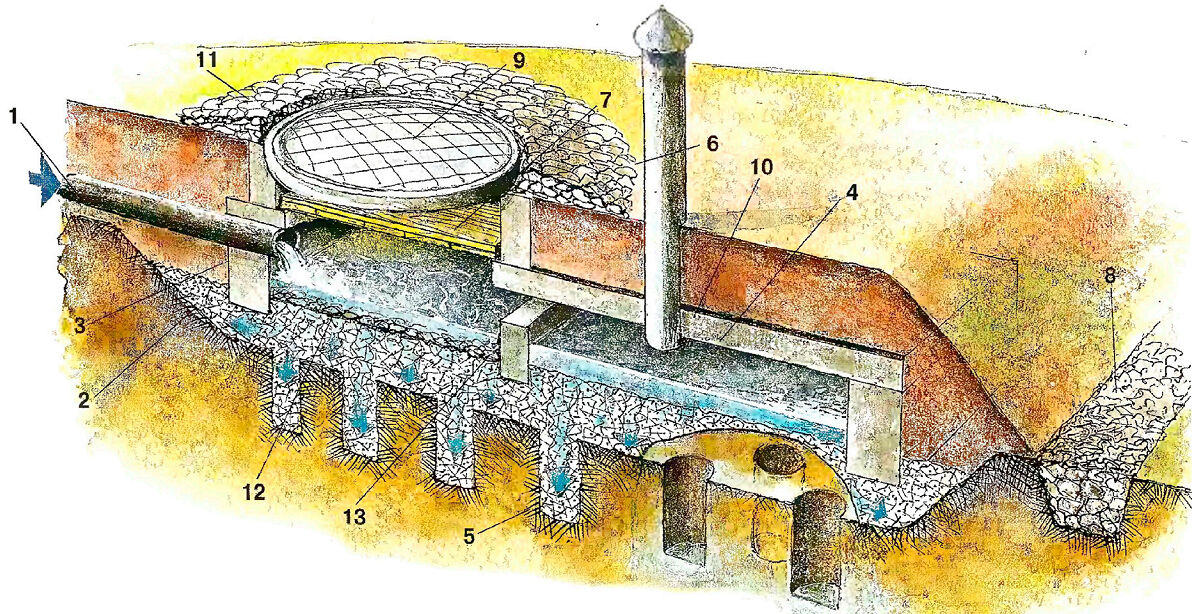
The filter cassette is analogous to the filtration field, but it is more expensive. This is the middle between the filter well and the aeration pipe system. It consists of a rectangular concrete tank with several partitions inside. From above, the structure is closed with concrete slabs (+)
This design is not widespread in the CIS countries.
You need to decide on the filtration system before installing a septic tank from concrete rings, as this will allow you to prepare a pit of the required size and depth in advance. Installing filtration systems after installation can damage pipes and tanks. Therefore, the space that borders the wall of the second sedimentation tank will have to be dug manually, without the use of special equipment.
Installation of a septic tank with two sedimentation tanks
Before starting work, it is necessary to check the groundwater level. This can be done if the house has a cellar or basement without a concrete bottom. It is necessary to measure the height from the ceiling to the surface layer of the soil. This is the depth to which you can dig.
To find out how deep the groundwater is, you can dig a small but deep hole. Groundwater begins when there is clearly damp earth. This is a sure sign, you don't need to dig further.
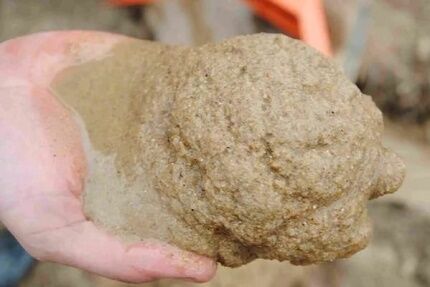
The depth of the appearance of groundwater can be determined by the appearance of the soil extracted from the pit. If it is saturated with water, then the depth of its extraction can be taken as an independently determined GWL
After the approximate groundwater level has become known, you can start earthworks. It is necessary to outline the place where the septic tank will be located. To do this, you need to outline the pits. To do this, you need to take a construction or any strong thread, measure 80 cm. Tie two pegs to both ends.
Stick one end in the middle of the place where you plan to place the first settling tank. Draw a circle. This is the approximate diameter of the pit you want. Next, you need to step back a meter, and draw the boundaries for the second container. Next, you need to outline the boundaries of the filtration structure.
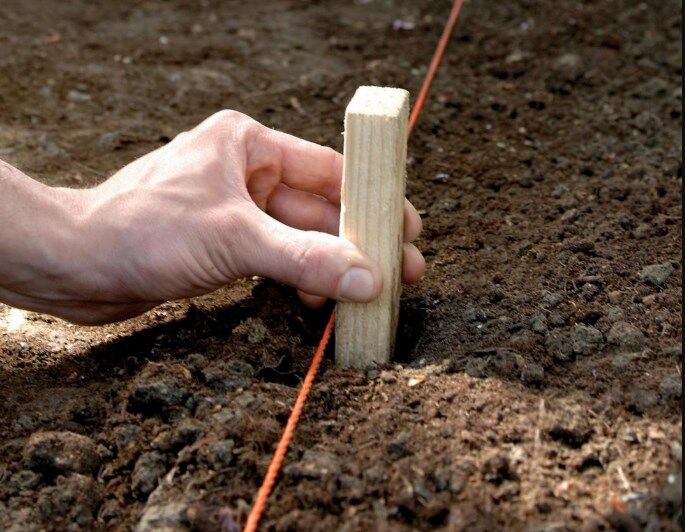
The boundaries of the pit must be surrounded by pegs around the perimeter, between which to pull the thread. This makes it easier to navigate when digging.
Consumables and tools
Before you start, you need to collect all the necessary materials and tools. For work you will need:
- hammer drill and a large drill for concrete;
- mixer attachment to the perforator;
- shovel and bayonet shovels;
- ladder;
- level:
- buckets;
- container for mixing the solution;
- durable nylon rope;
- hose;
Materials for mounting a septic tank from concrete rings:
- cement;
- sand;
- gravel;
- bitumen or liquid glass;
- metal staples;
- Mineral wool or expanded polystyrene;
After the equipment for all stages of work has been selected and prepared, you can start digging a hole.
How to dig pits for a septic tank
If you think that it is difficult to excavate soil in such volumes manually, therefore, you can use the services of organizations that have special equipment.
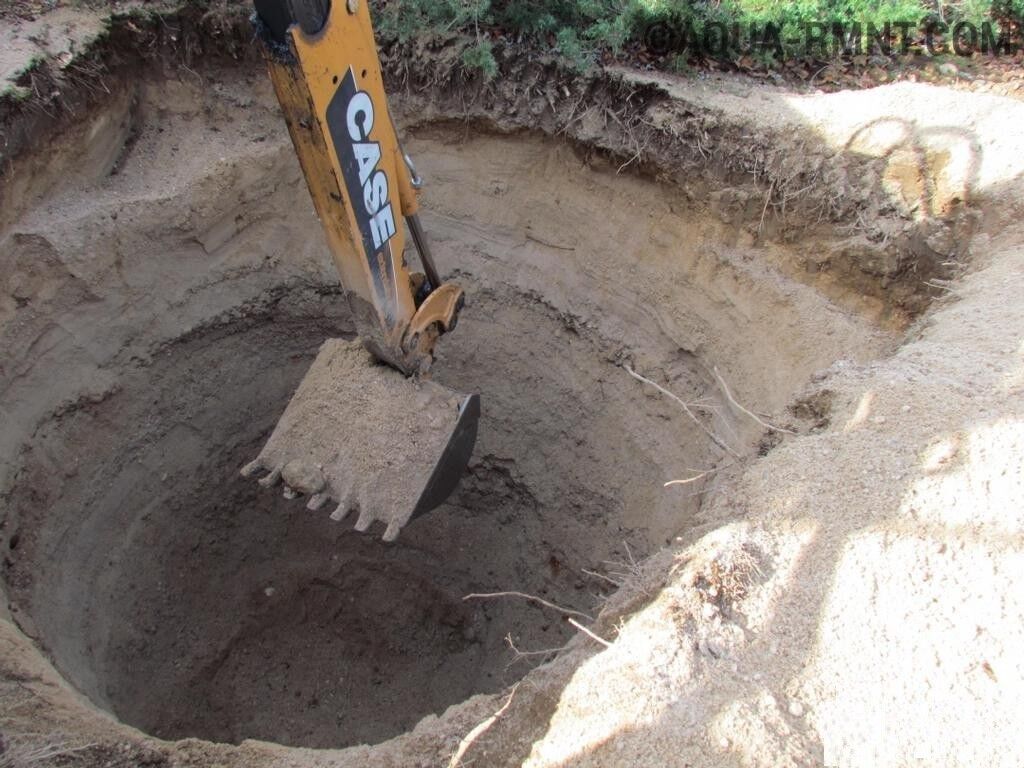
Together with the excavation of the pit, it is necessary to order the removal of excess soil, since the deep layers are, as a rule, loam, and are not suitable for use in garden plots.
Sand must be poured at the bottom of the pit, where the lower rings of the tanks will be installed. The thickness of the sand cushion is 20-25 cm. The base must be leveled. Next, the sand must be spilled with water so that shrinkage occurs. After pressing the sandy base, you can step over to the installation of the rings.
Installation of sedimentation tanks
To install the concrete rings for the septic tank that were previously brought to the site, you need to build a base. For this, a wooden formwork is arranged along the perimeter of the bottom of the pit. The height of the walls of the formwork should be at the level of 30-40 cm. After the construction of the formwork, it is necessary to lay the reinforcing mesh and dilute the cement mortar. To do this, you need to take 1 part of cement for three parts of ASG (a mixture of sand and gravel).
You can mix the solution using a construction mixer. You can add two tablespoons of liquid soap to the solution as a plasticizer. This will make the concrete more resistant to pressure and moisture. After pouring the base, you need to wait 10 - 14 days until the solution hardens and acquires the required strength. The formwork does not need to be removed. If rented equipment is used, it is more advisable to purchase ready-made concrete slabs as a base.
After the base is ready, you can mount the rings. The weight of the concrete structures is impressive, so a crane must be used. Installation of containers takes place in stages.
The first ring is immersed on the concrete base. Following it, the second is lowered and installed. The ring must be moved evenly, avoiding hitting or slipping. After installation, scraping is done.
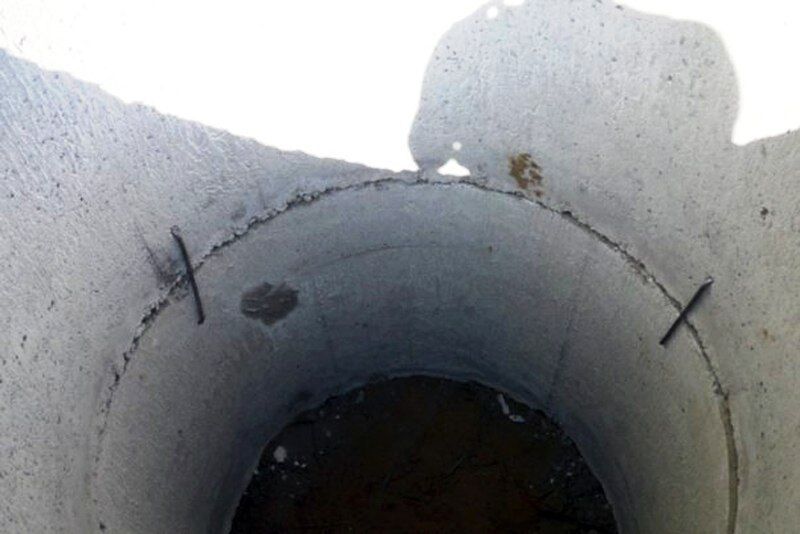
Holes are made in both rings at the edges, iron brackets are inserted into them, which are bent from the outer sides of the containers
In the next step, until the lid is lowered, it is necessary to cover the seams between the rings. After installing the overlap, it will become dark in the container and there is a risk of leaving untreated joints. For this, cement mortar is used. For ease of movement, running brackets are mounted inside the container. They are necessary for servicing the septic tank, in case of blockages or depressurization.
The adjacent sedimentation tank is installed in the same order. In both containers it is necessary to make holes for the sewer pipes and install them. The sewer inlet must be located higher than the overflow pipe between the tanks.

On top of the floors, you need to install one concrete ring of small diameter. Thus, a small chamber is obtained, which will isolate the container from the ingress of cold air.
This completes the installation of a septic tank made of concrete rings, and the installation of a ventilation system follows.
Ventilation system installation
Ventilation is necessary for the entry of air into the system, which ensures the normal functioning of microorganisms. They process domestic waste water and free it from organic matter. To ensure constant air circulation, two ventilation pipes are required.
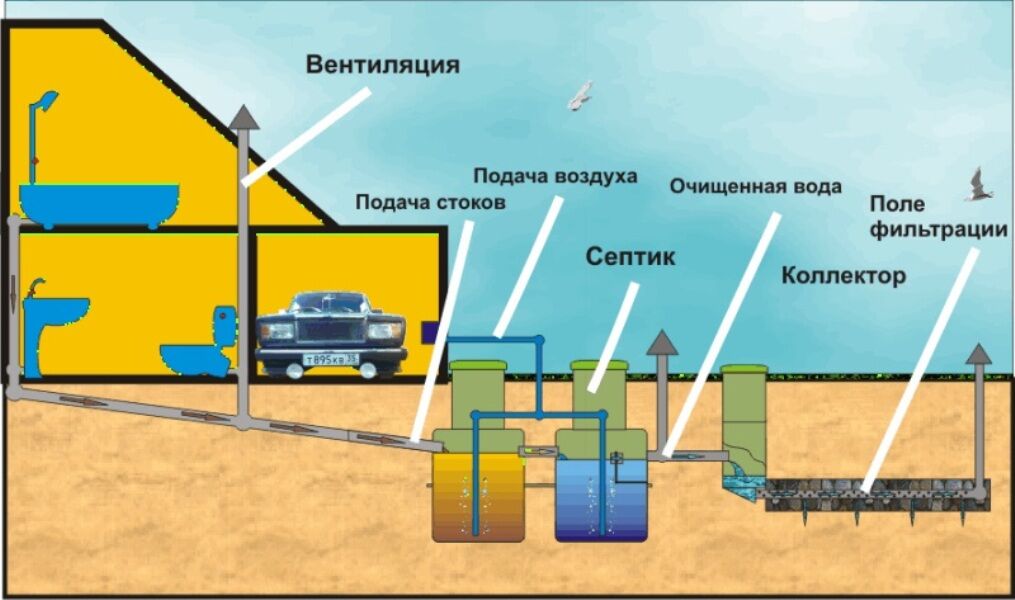
The first pipe is mounted in the section of the sewer pipe, which is as close as possible to the walls of the residential building. The best solution would be to mount it from the inside of the wall, but you can also mount it outside (+)
In this case, you will have to lay an electric cable to warm up the pipe, since when warm and cold air collide, condensation forms in it, which blocks the access of oxygen. It must be fixed with fasteners or clamps. The length of the vertically background riser must be at least the height of the wall of the house.
Ventilation also removes unpleasant odors that occasionally come from containers and can spread throughout the house. Often this happens when there is a prolonged absence of living and drying out of the liquid in the siphon.
The second pipe is mounted in the overlap of the sedimentation tank. To do this, using a perforator, a hole is punched in the ceiling, which coincides in diameter with the ventilation pipe. The air duct should rise 70-100 cm above the earth's surface. The position of this pipe will be fixed by the weight of the soil and does not need additional fastening.
Installation of aeration field
From the second concrete tank, a pipe emerges into a distribution well. For the well, you can use a polyethylene barrel, in which you can cut holes suitable for aeration pipes.
You can purchase a ready-made distribution well.
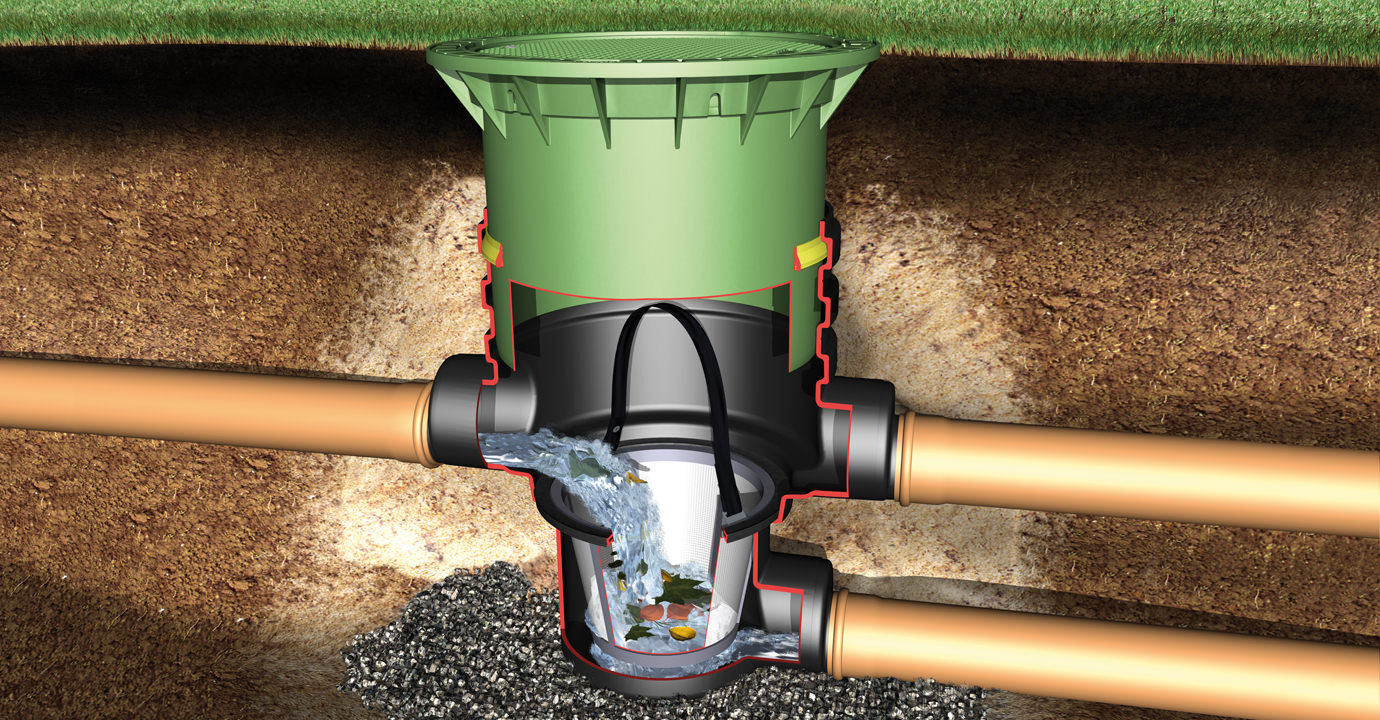
It is produced by many companies that manufacture cleaning systems. You can buy a ready-made aeration field for the distribution well or make it yourself from sewer pipes
To do this, you need to purchase pipes based on the size of the field. For a family of four, an area of 20 square meters (10 × 2) is sufficient. This will require three pipes 10 m long. In addition, you will need three corner pipes, where the ventilation pipes will be installed.
The field is pre-filled with sand and gravel to improve the absorption capacity of the soil.
Perforated pipes connected to a distribution well are laid on the prepared drainage. At the ends of the aeration pipes, corner pipes are mounted, into which the background riser is installed, one for each pipe. After that, the pipes are covered with geotextiles and covered with a mixture of gravel and sand, then leveled. As the siltation progresses, the aeration field must be moved or cleaned by changing the drainage.
Installation of a filter well
The filter well has a number of advantages over the aeration field. It takes up less usable area on the site. But the quality of the treated water will be higher near the aeration field, since before entering the groundwater, the drains will be filtered by soil, and its layer under the aeration field is much larger than that of a well with drainage. The area of the well cannot cope with the amount of wastewater that the aeration section receives.
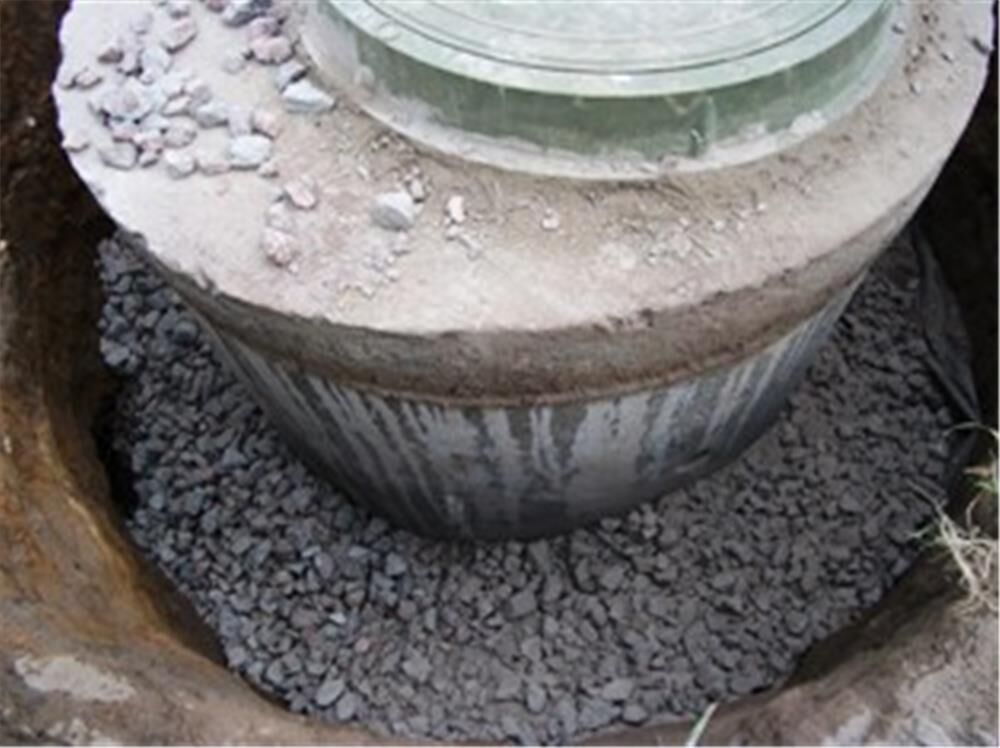
It is necessary to locate the filtration well at a distance of at least 2 meters from the sedimentation tank. This is necessary in order to exclude soil movement and deformation of the foundation in the event of emergency leaks and flooding.
It is worth installing a well according to the same principles as sedimentation tanks, excluding concreting the bottom of the tank. At the bottom of the well, in addition to the sand cushion, it is necessary to place crushed stone, gravel, or other filtering composition. The standard capacity of the soil filter in the absorption well is calculated from 1 m or more.
In order to increase its capacity, it is possible to supplement the filtration well with a side drain. For its construction, the lower concrete ring of the septic tank must be perforated.
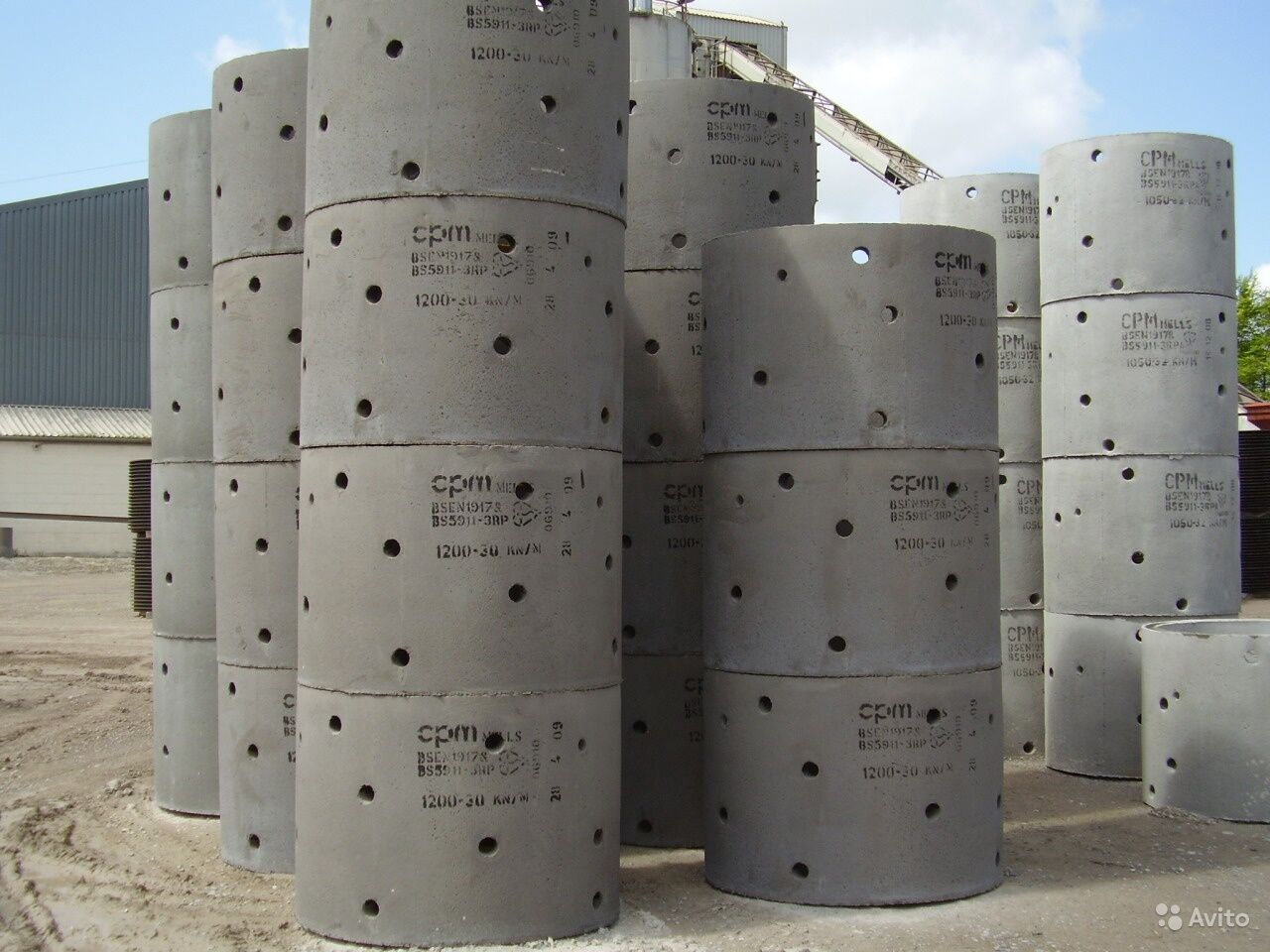
You can find ring models that already contain holes, but it is difficult to find them. Therefore, it is more advisable to make holes on your own using a punch.
This process is best done on the surface, before the ring is lowered into the pit. You also need to make a hole for the overflow of water from the sedimentation tank, it should be located slightly lower than the previous overflow.
The walls and joints of the filter well must be fastened with staples, but there is no need to seal them. By connecting the overflows, you can bury the structure. The first ring must be sprinkled with rubble from the outside, up to the junction with the second segment. The rest of the volume can be covered with soil from the backyard.
Launch preparation process
If the temperature in winter falls below 30 degrees, it is necessary to prepare insulation for the inner hatch cover. Since the container itself is located below the freezing level, it does not need additional insulation.
To insulate the lid, you need to take foam and cut out a circle that fits the diameter of the inner small concrete ring.

Styrofoam is practically non-degradable and will last for many years.To make it easy to remove it to check the septic tank, you can make a hole in the middle where you can insert a nylon rope. On the back of the foam, the rope should be tied to a short and narrow board, and the other end should be left
Next, you need to cut out the cover itself. For this, ordinary plywood of sufficient strength is suitable. You can screw the door handle to it in order to make it convenient to open. Similarly, it is worth insulating the inner covers of the second sedimentation tank and drainage well.
Before using the septic tank, the first sedimentation tank must be filled with water to 1⁄4 of its volume. Pour a biological product into the filled container, which will help the septic tank to reach full capacity faster. After these steps, you must close the hatches.
Video how to install a septic tank
The video shows the installation process of a two-chamber septic tank in stages:
How the septic system works:
If the construction of a septic system from concrete rings is made in compliance with the rules, it will last for 20 years. We must not forget about the rules of operation and perform maintenance in a timely manner. The pipes are made of plastic, so they can be easily damaged. It is strictly forbidden to park equipment or a car in the place where the tanks are located.



